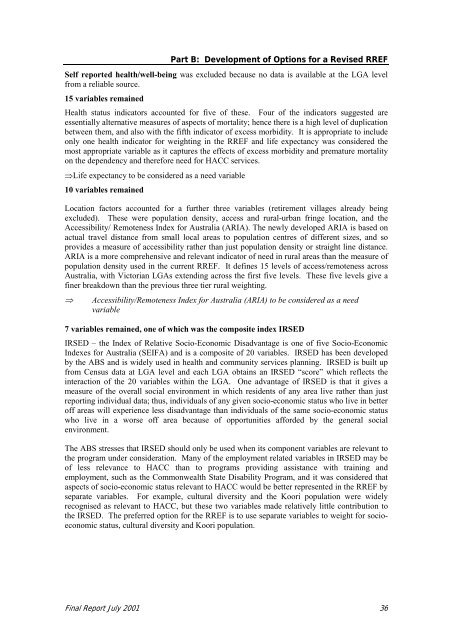Final Report on RREF 2001 - Department of Health
Final Report on RREF 2001 - Department of Health
Final Report on RREF 2001 - Department of Health
You also want an ePaper? Increase the reach of your titles
YUMPU automatically turns print PDFs into web optimized ePapers that Google loves.
Part B: Development <strong>of</strong> Opti<strong>on</strong>s for a Revised <strong>RREF</strong><br />
Self reported health/well-being was excluded because no data is available at the LGA level<br />
from a reliable source.<br />
15 variables remained<br />
<strong>Health</strong> status indicators accounted for five <strong>of</strong> these. Four <strong>of</strong> the indicators suggested are<br />
essentially alternative measures <strong>of</strong> aspects <strong>of</strong> mortality; hence there is a high level <strong>of</strong> duplicati<strong>on</strong><br />
between them, and also with the fifth indicator <strong>of</strong> excess morbidity. It is appropriate to include<br />
<strong>on</strong>ly <strong>on</strong>e health indicator for weighting in the <strong>RREF</strong> and life expectancy was c<strong>on</strong>sidered the<br />
most appropriate variable as it captures the effects <strong>of</strong> excess morbidity and premature mortality<br />
<strong>on</strong> the dependency and therefore need for HACC services.<br />
⇒Life expectancy to be c<strong>on</strong>sidered as a need variable<br />
10 variables remained<br />
Locati<strong>on</strong> factors accounted for a further three variables (retirement villages already being<br />
excluded). These were populati<strong>on</strong> density, access and rural-urban fringe locati<strong>on</strong>, and the<br />
Accessibility/ Remoteness Index for Australia (ARIA). The newly developed ARIA is based <strong>on</strong><br />
actual travel distance from small local areas to populati<strong>on</strong> centres <strong>of</strong> different sizes, and so<br />
provides a measure <strong>of</strong> accessibility rather than just populati<strong>on</strong> density or straight line distance.<br />
ARIA is a more comprehensive and relevant indicator <strong>of</strong> need in rural areas than the measure <strong>of</strong><br />
populati<strong>on</strong> density used in the current <strong>RREF</strong>. It defines 15 levels <strong>of</strong> access/remoteness across<br />
Australia, with Victorian LGAs extending across the first five levels. These five levels give a<br />
finer breakdown than the previous three tier rural weighting.<br />
⇒<br />
Accessibility/Remoteness Index for Australia (ARIA) to be c<strong>on</strong>sidered as a need<br />
variable<br />
7 variables remained, <strong>on</strong>e <strong>of</strong> which was the composite index IRSED<br />
IRSED – the Index <strong>of</strong> Relative Socio-Ec<strong>on</strong>omic Disadvantage is <strong>on</strong>e <strong>of</strong> five Socio-Ec<strong>on</strong>omic<br />
Indexes for Australia (SEIFA) and is a composite <strong>of</strong> 20 variables. IRSED has been developed<br />
by the ABS and is widely used in health and community services planning. IRSED is built up<br />
from Census data at LGA level and each LGA obtains an IRSED “score” which reflects the<br />
interacti<strong>on</strong> <strong>of</strong> the 20 variables within the LGA. One advantage <strong>of</strong> IRSED is that it gives a<br />
measure <strong>of</strong> the overall social envir<strong>on</strong>ment in which residents <strong>of</strong> any area live rather than just<br />
reporting individual data; thus, individuals <strong>of</strong> any given socio-ec<strong>on</strong>omic status who live in better<br />
<strong>of</strong>f areas will experience less disadvantage than individuals <strong>of</strong> the same socio-ec<strong>on</strong>omic status<br />
who live in a worse <strong>of</strong>f area because <strong>of</strong> opportunities afforded by the general social<br />
envir<strong>on</strong>ment.<br />
The ABS stresses that IRSED should <strong>on</strong>ly be used when its comp<strong>on</strong>ent variables are relevant to<br />
the program under c<strong>on</strong>siderati<strong>on</strong>. Many <strong>of</strong> the employment related variables in IRSED may be<br />
<strong>of</strong> less relevance to HACC than to programs providing assistance with training and<br />
employment, such as the Comm<strong>on</strong>wealth State Disability Program, and it was c<strong>on</strong>sidered that<br />
aspects <strong>of</strong> socio-ec<strong>on</strong>omic status relevant to HACC would be better represented in the <strong>RREF</strong> by<br />
separate variables. For example, cultural diversity and the Koori populati<strong>on</strong> were widely<br />
recognised as relevant to HACC, but these two variables made relatively little c<strong>on</strong>tributi<strong>on</strong> to<br />
the IRSED. The preferred opti<strong>on</strong> for the <strong>RREF</strong> is to use separate variables to weight for socioec<strong>on</strong>omic<br />
status, cultural diversity and Koori populati<strong>on</strong>.<br />
<str<strong>on</strong>g>Final</str<strong>on</strong>g> <str<strong>on</strong>g>Report</str<strong>on</strong>g> July <strong>2001</strong> 36
















